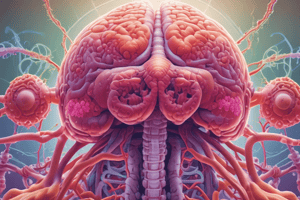Podcast
Questions and Answers
What is one method the respiratory system uses to prevent microorganisms from entering?
What is one method the respiratory system uses to prevent microorganisms from entering?
- Relaxation of throat muscles
- Presence of mucous membranes (correct)
- Increased ciliary movement (correct)
- High oxygen levels
Which option is a primary factor that keeps the lower respiratory tract sterile?
Which option is a primary factor that keeps the lower respiratory tract sterile?
- High acidity of the lungs
- Frequent coughing
- Microbial growth in alveoli
- Efficient filtration from nasal passages (correct)
What kind of diseases can result from bacterial infections in the respiratory system?
What kind of diseases can result from bacterial infections in the respiratory system?
- Digestive disorders
- Respiratory diseases (correct)
- Neurological disorders
- Cardiovascular diseases
How does periodontal disease relate to respiratory diseases?
How does periodontal disease relate to respiratory diseases?
What is an essential characteristic of bacterial pathogens that affect the respiratory system?
What is an essential characteristic of bacterial pathogens that affect the respiratory system?
What is the primary role of the ciliary escalator in the respiratory system?
What is the primary role of the ciliary escalator in the respiratory system?
Which of the following pathogens is associated with cystic fibrosis as an opportunistic infection?
Which of the following pathogens is associated with cystic fibrosis as an opportunistic infection?
Where is the normal respiratory tract flora primarily located?
Where is the normal respiratory tract flora primarily located?
How do bacterial respiratory infections typically occur?
How do bacterial respiratory infections typically occur?
What condition can be exacerbated by the presence of periodontal disease?
What condition can be exacerbated by the presence of periodontal disease?
Flashcards
Respiratory System Immunity
Respiratory System Immunity
Mechanisms protecting the respiratory tract from pathogens.
Preventing Microorganism Entry
Preventing Microorganism Entry
Methods that stop microbes from entering the lower respiratory tract.
Normal Flora of RT
Normal Flora of RT
Microorganisms commonly found in the respiratory tract, typically harmless.
Bacterial Respiratory Infections
Bacterial Respiratory Infections
Signup and view all the flashcards
Periodontal-Respiratory Link
Periodontal-Respiratory Link
Signup and view all the flashcards
Normal Respiratory Tract Flora
Normal Respiratory Tract Flora
Signup and view all the flashcards
Respiratory Transmission
Respiratory Transmission
Signup and view all the flashcards
Opportunistic Pathogens
Opportunistic Pathogens
Signup and view all the flashcards
Alveoli
Alveoli
Signup and view all the flashcards
Nosocomial Pathogen
Nosocomial Pathogen
Signup and view all the flashcards
Study Notes
Bacterial Infections of the Respiratory System
- Immune defense of the respiratory system prevents microorganisms from entering.
- Hair in nasal passages
- IgA antibodies
- Normal microbiota of the oropharynx
- Ciliary escalator
- Alveolar macrophages
Normal Respiratory Tract Flora
- Bacteria are found in the upper respiratory tract.
- The lower respiratory system (alveoli) is normally sterile.
Respiratory Transmission of Infections
- Bacteria are spread by droplets from the mouth.
- Droplets fall within 6 feet.
- Airborne transmission.
Periodontal Disease & Respiratory Disease
- Periodontal disease and respiratory diseases are linked.
- Bacteria in plaque can travel to the lower respiratory tract.
- This can cause pneumonia, COPD, and bronchitis.
- Periodontal pathogens are found in subgingival plaque and tracheal aspirates of patients with severe COPD.
- The oral microbiome carries respiratory pathogens.
- Periodontal disease worsens COPD and other respiratory conditions.
Smoking & Respiratory Infections
- Smoking is a leading cause of COPD and other respiratory diseases.
- Tobacco use damages gingiva and oral health.
- Smoking deepens gum pockets and accelerates attachment loss.
Upper Respiratory Tract Infections (URTI)
- Anatomy of the upper respiratory tract:
- Frontal air sinus
- Nasal bone
- Middle concha
- Inferior concha
- Hard palate
- Mandible
- Sphenoidal air sinus
- Sella turcica
- Auditory tube
- Pharyngeal tonsil
- Nasopharynx
- Uvula
- Palatine tonsil
- Oropharynx
- Lingual tonsil
- Hyoid bone
- Thyroid cartilage
- Vocal cords
- Epiglottis
- Laryngopharynx
Otitis Media
- Infection of the middle ear.
- Mostly viral, but can be bacterial.
- Children are at high risk due to small eustachian tube openings.
- Risk factors: spread from throat/sinus infections.
- Fluid trapped behind the ear drum leads to middle ear infection.
- Symptoms: fever, ear pain, hearing problems.
- Diagnosis: otoscope.
- Complications: mastoiditis, facial nerve palsy, meningitis, brain abscess, hearing problems.
Sinusitis
- Inflammation of paranasal sinuses (commonly maxillary).
- Usually begins as a viral infection, obstructing sinus openings and leading to mucus accumulation.
- Can result in secondary bacterial infection.
- Symptoms: fever, purulent nasal discharge, headache, facial pain.
- Diagnosis: Clinical examination.
- Complications: osteomyelitis, orbital cellulitis, cavernous sinus thrombosis, intracranial complications.
- Odontogenic sinusitis: sinusitis from dental infection.
Pharyngitis (Throat Infections)
- Inflammation of the throat, painful swallowing.
- Most common cause is viral.
- Bacterial pharyngitis is less common (10%).
- Centor Criteria suggests bacterial infection (Streptococcus pyogenes).
Lower Respiratory Tract Infections (LRTI)
- Pneumonia: inflammation of the lungs (alveoli), transmitted via inhalation of virulent pathogens or from the oropharynx.
- Symptoms: cough, fever, chest pain, shortness of breath, rusty/currant jelly sputum.
- Community-acquired vs Healthcare/Ventilator-associated pneumonia.
- Predisposing factors: poor oral health.
- Complications: blood infection (septicemia), CNS infection (meningitis), empyema, pericarditis, endobronchial obstruction, abscess.
Pneumonia (Community Acquired)
- Transmission from community via upper respiratory tract (inhalation of virulent organisms).
- Predisposing factors: high rates of oral streptococci and anaerobes.
- Oral health management is important to prevent.
Opportunistic Infections in Immunocompromised Persons
- Immunocompromised hosts are at higher risk for opportunistic infections.
- Groups: HIV/AIDS, solid organ/hematopoietic cell transplants, malignancy/chemotherapy, primary/acquired immunodeficiencies, autoimmune conditions, cystic fibrosis, diabetes mellitus.
- Chronic respiratory problems increase the risk of periodontal disease.
Tuberculosis (TB)
- Mycobacterium tuberculosis.
- Obligate aerobic bacteria.
- Long treatment time (at least 6 months).
- Pulmonary TB is transmitted by respiratory aerosols.
- Symptoms: productive cough, weight loss, night sweats.
- Diagnosis: sputum culture, tuberculin skin test.
- Chest x-ray to reveal abnormalities.
- Dental procedures should be planned for those with TB
Pseudomonas aeruginosa
- Gram-negative bacilli.
- Commonly found in the environment (soil, water).
- Found in some as normal flora of the colon.
- Two pigments: pyocyanin (blue), pyoverdin (yellow-green).
- Exotoxin A causes tissue necrosis.
- Often requires multiple-drug treatment combination.
Studying That Suits You
Use AI to generate personalized quizzes and flashcards to suit your learning preferences.
Related Documents
Description
This quiz explores the immune defenses of the respiratory system, including the role of normal respiratory tract flora and the transmission of bacterial infections. It also discusses the link between periodontal disease and respiratory conditions such as pneumonia and COPD. Test your knowledge on these critical aspects of respiratory health.





